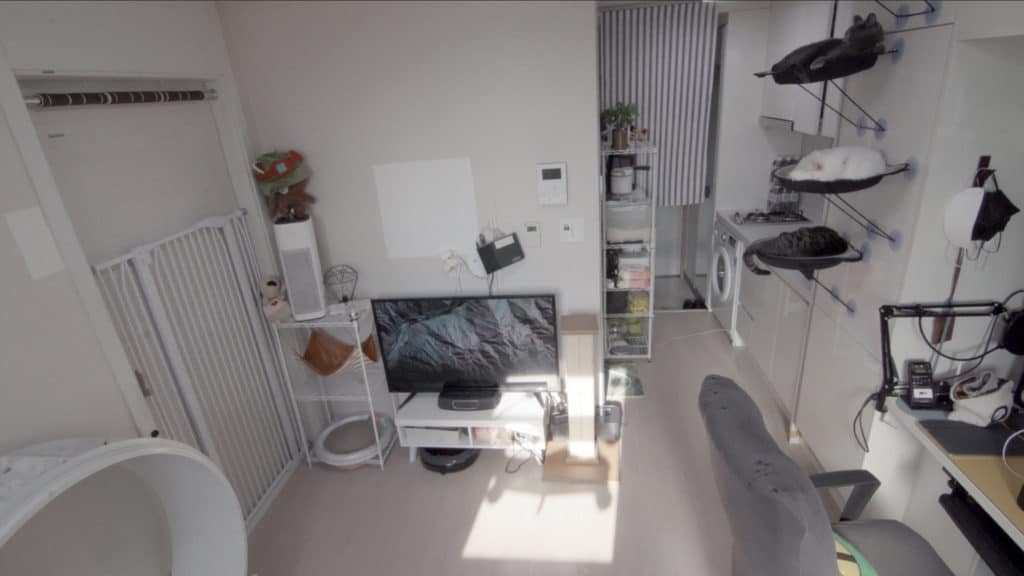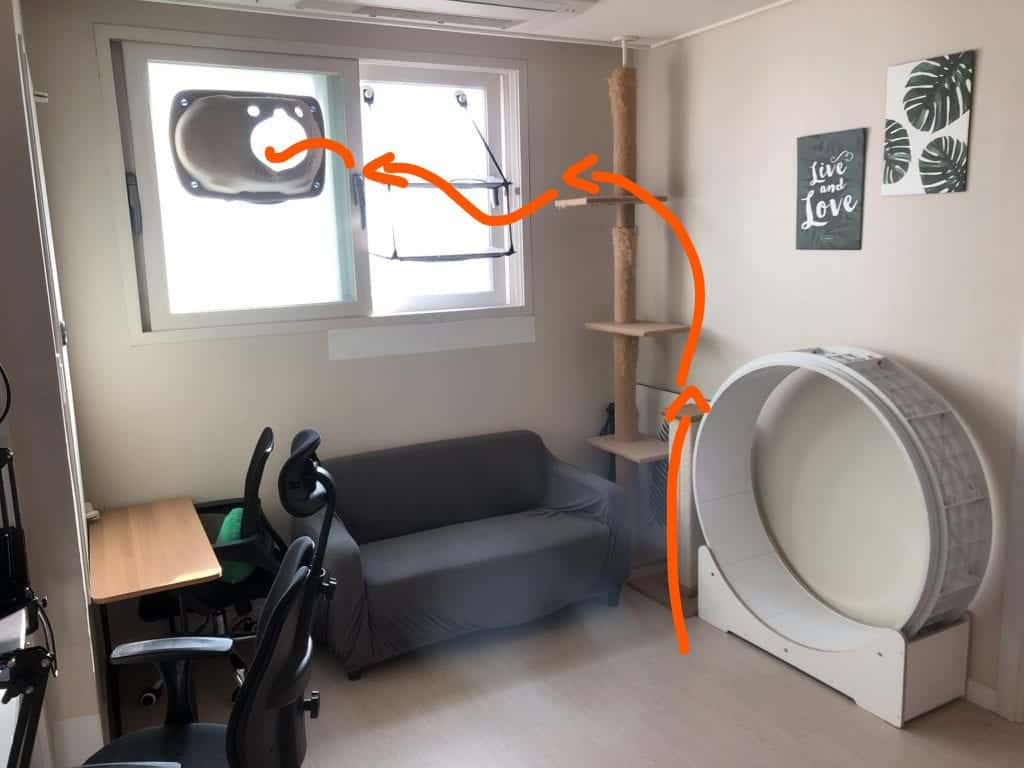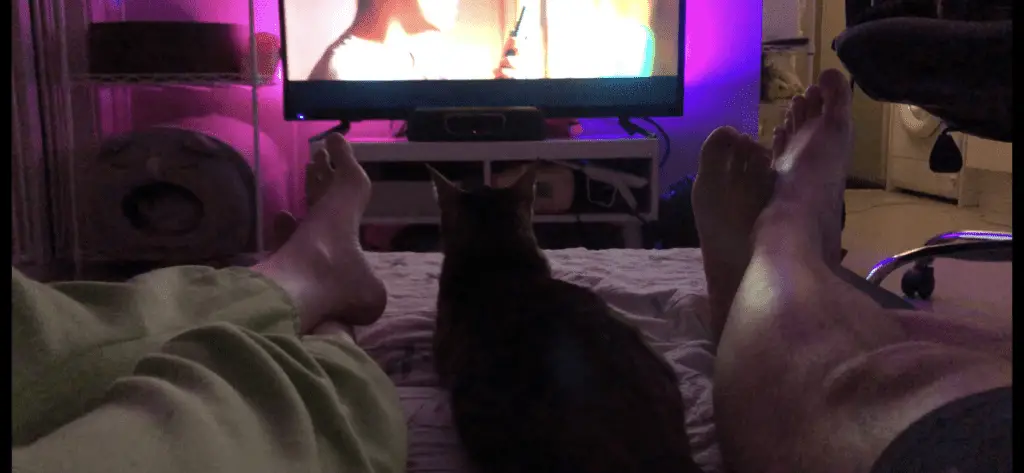Cats are wonderful companions and they’re very different from their canine counterparts. While they need a lot of attention like any other animal, having a cat means that you might need some different skill sets and knowledge when compared to having any other animal.
This guide is to help you navigate the common problems and questions that a prospective cat owner might come across and not only prepare for your feline friend but also understand them a little bit better.
This guide is to also help everyone to create an environment for your cats that is both stimulating for them and their owners – allowing for each party (feline or not) to have their needs fulfilled.
Can a Cat Live in an Apartment?
If you’re reading this then you’re probably thinking of getting a cat and have concerns about whether or not it’s feasible to have cats in a small space or apartment.
So can a cat live in an apartment? The answer is a resounding yes, not only a normal apartment but studio apartments too! You can live with up to 3-4 cats in a studio apartment (about 20 square meters) comfortably with preparation and a couple of changes to your room to accommodate your cats!

Take it from a person that’s personally lived with 3 cats in a studio apartment (20 square meters) and is currently giving with 4 cats in a bit larger apartment (but still small at 30 square meters), it’s very likely that you do have enough room. They are not only healthy living in this space, but very happy and affectionate.
Though as with any animal, a cat is a living animal that you have to take on and be responsible for providing the best lives for them that you can no matter what size of home you may have. In an apartment that might take a little bit more preparation and creativity.
In an apartment, the focus is to provide vertical progression and promote an active lifestyle rather than a sedentary one. The way to achieve is through proper furniture arrangements and a good routine.
A regular outdoor cat always has the opportunity to run and chase things around when it feels bored while an indoor cat doesn’t.
The reasons for this are coming up in the next sections.
For a more general guide about living with pets in apartments: How to Live in a Small Apartment with Pets (5 Key Principles!)
Common Safety and Health Concerns For Cats in Apartments
Living in an apartment has its own risks and safety concerns but has nowhere near the number of dangers and risks that an outdoor cat has. However, it’s still important to take note of these risks to make sure our cats are safe and healthy.
Safety Risks and Concerns
- Biting of cables and other electronic objects around the home
- Small hidden areas in which cats can either hide in or be trapped
- Chemicals and substances that could be harmful
- Small objects that can be accidentally swallowed
- Getting stepped on – this is a little bit more of a concern in a smaller space like apartments (especially studio apartments!). It’s a very common accident that happens and even though it’s usually minor (like a stepped-on tail) – there might be a day when it’s not minor. Another reason why it’s important to have a good arrangement (explained below) for your apartment to minimize this risk.
Health Risks and Concerns
Most of these health risks have to do with an indoor cat’s lack of physical stimulation. This is why our focus in our apartment arrangement is to try to facilitate as much physical activity and exercise as possible because it tackles all of these health issues all at once.
- Obesity and diabetes – without a doubt the number one issue with indoor cats. Overeating, lethargy, and lack of stimulation play a part.
- Urinary tract disease (painful urination or difficult to urinate, basically urination issues) – again, usually a symptom of the above – just not enough stimulation, physical or mental.
- Stress/Separation Anxiety/Boredom – an indoor cat just doesn’t have the excitement and stimulation that an outdoor cat does despite being much safer living inside. Cats still need to fulfill their purpose as cats instinctually whether it’s living inside or outside.
Minimum Apartment Size for Living With Cats
Cats are creatures that don’t need a very large space to live in. A well-thought-out apartment for cats is always going to be better than a very large home that is double or triple the size of the apartment that is not trying to satisfy the needs of their cats.

Now assuming that you’re going to try to catify (making adjustments to your home to accommodate your cat’s needs) your apartment – an apartment that is 15 square meters is going to be more than enough for one cat.
For the complete recommendations for size and other details visit my article: Is Your Apartment Big Enough for a Cat or Multiple Cats?
However, for multiple cats, a bit larger size at approximately 20 square meters would be recommended as it would give you more options and areas to catify.
As said before, many people are surprised that I live in a 30 square meter apartment with 4 cats. However, when they actually step into my apartment – they hardly notice the cats.
How small is too small for a cat? If for some reason a potential cat owner cannot provide or satisfy the needs of a cat either physically (safe, essential supplies, etc.) or instinctually (play situations, catificaton, etc.) then it’s probably a good decision to hold off on getting a cat.
Simply because I put some thought into the design and layout of my apartment. See below for tips on the catification of your apartment!
What To Do Before New Cat/Kitten Arrives In Apartment
Before the cat arrives, there are a few things that should be done for the easiest and quickest transition for your new cat. I like to tackle the hardest stuff first and then work towards the easier ones.
There are a lot of ways we can help the new cat become more adjusted to the new home/apartment. The more of them we can consider and apply in our apartment, the more time it takes for them to feel comfortable is substantially reduced.
Here’s a list of the things to do before the new cat or kitten arrives in your apartment – listed from the hardest (most effort) to the easiest (least effort):
- Block off all ‘unders’ – under the bed, under the couch, or under a cabinet. A cat that is afraid, will try to go under those items. Now we try to block it off not only for sanitary reasons (it’s pretty dusty down there) but also for the cat’s confidence.
Like any animal that’s shy at first, we always want to push their comfort zone. Timid/shy cats love to go under furniture and they can stay there for hours without moving. This causes problems because then the owner caves in and give them food or water under the bed which continues to reinforce this behavior.
This doesn’t help their adaptation time so we need to try to snip it at the bud by blocking it off completely in the beginning. We can add more private/closed off places to go in but that’s places that we control the placement of(hammocks, cat beds, cat caves, etc.).
This means that if they want to get away from something – they have to climb to the higher spots. This is much better for your cat’s confidence because they can actually survey what’s around them and understand that there’s no threat. Rather than being completely scared and oblivious under the bed or sofa.
If you look around in my apartment – there are very few places that a cat can go under. - Plan out ‘cat’ zones and ‘human’ zones. In a studio apartment, there isn’t portioned off areas or walls but there are a lot of walls and maybe a large window.
Utilize those areas and create a ‘cat wall’ as I like to call it. A wall/window in which cats can climb to, play, or hang out. 80% of the time, cats are going to be on the wall and not on the ground and that’s what we want.
Cats on the ground are not only unsafe for the cats but are a hazard for humans too! It also frees up space for the things we need to do in our apartment.
Plan out how they might move from the lowest part in the room to the highest part in the room. Maybe from the couch, to cat pole, to cat hammock, and maybe to a bookcase that’s on the wall. - Organize cables and put away other harmful objects. Get the wires and other small electronic items out of the way. Cats love to chew on protruding things such as USB plugs sticking out of the sockets. Make sure that’s either inside a drawer or behind something so that it’s not in a cat’s natural line of sight.
Using power strip cover organizer boxes help too to help keep things neat and organized in addition to keeping wires away.
One thing to note is that if you’re adding a kitten to your home, it’s a very good idea to actually have things around the home to bite especially as their teeth start to grow in. Matatabi sticks are great for this and you create associations that some things are meant to be bitten and other things not.
The computer area is an important area to do this in – to prevent accidents and damage to our cats and equipment. If you’re going to have cats – know how to cat-proof your computer and work area! - Put the litter box in a socially important area. This doesn’t mean put it in the middle of the room, but what it does mean is to put it in a place that has a lot of traffic or different scents. This is easy to do in a small apartment for the most part.
The litter box can be a big source of pain and stress to a lot of people if our cats don’t use it properly. So let’s not deal with it and do it right from the beginning.
What I wouldn’t recommend, is to hide the litter box in a cabinet or drawer like some people like to do. It causes more problems than it solves and it could develop into problems if there are multiple cats around.
For more information about where to place your cat apartment and why it matters, read my article about it here: where should you keep the litter box in a small apartment.
For a full extensive guide on how to prevent the worst problems with the litter box, what litter type to use, and what litter box to use – read the apartment litter box solutions guide.
A lot of cat owners also worry about bad odors from the litter box. While litter and waste are going to smell if you don’t scoop daily – there are lots of things we can do to keep litter fresh.

How to Satisfy A Cat’s Needs In An Apartment Easily and Efficiently
If a dog needs to walk, what does a cat need to do to feel like a cat? To hunt, climb, run, and play. Think about how a cat would spend its time outdoors and try to incorporate as much of it inside your apartment as possible.
Now the question is: can you fit all of these into your apartment area while at the same time still giving us cat butlers the space that you need to live in and work in your daily lives?
Below will show a chart outlining a cat’s instincts and how to satisfy these needs simply and easily without spending a lot of money nor be too intrusive as to take up a lot of floor space in an apartment.
| Instinctual Need To Be Satisfied | Explanation and Solutions |
| Scratching | There are a couple of different ways a cat likes to scratch. However, the common thread that a good scratcher has is that it’s wide, stable, and doesn’t move around when the cat scratches on it. There are two types of ways a cat likes to scratch: 1. They like to stretch out their bodies while they scratch and 2. Horizontal axis scratching so that they can get a good grip and peel off the layers of their claws. So provide them with a nice tall, and sturdy scratcher. I recommend this one that has lasted me over a year and still is being used every day by my 4 cats: The Pioneer Ultimate Cat Scratcher! For the horizontal scratchers, there are a lot of options but the ones I like to use are a little more angled so the cats get a good scratch. So when getting scratchers – it’s a good idea to cover both bases and get a tall scratcher and a more horizontal/flat scratching post. There are also cat breeds that are less likely to scratch furniture if you’re willing to go with a purebred cat. They can be expensive but if you’re looking for certain traits it’s worth it. See my article on Cat Breeds That Don’t Scratch Furniture |
| Biting | Cats also like to bite – however we don’t want them to bite the wrong things like our cables and electronics nor our hands. Always have stuff around the home that you can throw around that they can bite. The previously discussed one being matatabi sticks – very cheap and very useful for a chewing toy that both cleans their teeth and gets their chewing cravings out. Other things that cats like to bite are actually soft textured items. Things they can wrestle and kick without worry about scratching it up badly or hurting it. For example, if you’ve ever seen those catnip fish around. Some of my cats will grab a hold of it and bite it like a maniac. It’s really effective again, training them that certain textures and materials are meant to be used for biting. It’s important to be consistent with what they can or can’t bite or else they will grow up learning to bite hands or other stuff around the house. If you are concerned and want to have a well-adapted adult cat, click here (How to Stop an Active Cat From Biting). |
| Running | One of the big activities that an apartment cat lacks when compared to an outdoor cat. They can’t really go on full-on sprints. This is one of the things that is difficult to implement inside a small apartment because the one thing that allows running/sprinting is a cat wheel. Which is both space investment and quite a financial investment as well. For me, it has been worth it for my ultra-active Bengal cat but for other people, it might not depending on their cat’s activity levels. If you’re wondering about cat wheels or wondering yourself if it’s worth it for you in your living situation, have a look at my article: Are Cat Wheels Worth It? Complete Cat Wheel Guide. Is there a more cost-effective alternative to cat wheels to incorporate running? I don’t think so. If I wasn’t able to afford my cat wheels, I would look towards enhancing more of another aspect of the physical lifestyle of an outdoor cat. Climbing (explained below). |
| Climbing/Jumping | Climbing is just something that a cat can do very naturally and easily. In an indoor situation like a studio apartment, this is the aspect that I would focus on. This hits on all the notes of saving space and keeping your cats healthy. When cats have so many things they can climb and get to, they have no choice but to be active. When I talk about this, a lot of people think about cat towers first. While it is a good starting point, I actually don’t like cat towers that much. It takes up too much room and after the first couple of days, all they do is lie on it and sleep. Rather than cat towers, I would rather have a cat pole that extends from the bottom of the room to the top ceiling. Not only does it promote a lot of climbing and play, but it also allows them to access areas that they wouldn’t have been able to reach before. Whether that means window hammocks or another ledge in your apartment. It can create a lot of unexpected routes for your cat to go to. Another thing to think about is the surfaces that you don’t want your cats to be on (computer tables, kitchen counters, or dinner tables). Having perches and elevated areas around those surfaces allow the cats to interact and involve themselves without them being on the surfaces themselves. |
| Hiding and Burrowing | We all know that cats are really good at catching those pesky rodents. This means that they themselves are pretty adept themselves at hiding and burrowing in places that a rodent might be. Cat owners will always be surprised about where a cat might get itself into. This is why it’s important to provide these types of places as well. In an apartment, this can be hard to do but there are a lot of collapsible tunnel toys or other similar toys that create an environment in which the cats can burrow, hide, and play. These toy tunnels are great because when the cats are finished with them, you can easily put them away and it takes almost no room at all to store. It’s also great for those times that you are just too busy to play with your cats. |
| Hunting | Cats in the wild hunt for their food. While they don’t need to do it anymore, even domestic cats outdoors get the chance to hunt (much to our dismay) even though they get free food from their humans. While we might think cats are a bit aloof and do whatever they want, but a lot of their behavior comes from being a hunter. Their hunting tick is what makes them what they are. So how does an indoor apartment cat satisfy this itch to hunt? Through interactive play. Cats can seem bored one minute and then the next they can be in a trance because something is moving around on the floor. Interactive play can change an unfriendly, timid, cat into a cat that’s well-behaved and confident. So what are the main ways to interactively play? The most common way is the wand toy, which is just a stick with maybe a feather or something on the end of it and the cat will be more than happy to chase it around. Fetch is also another great way to play with your cat because balls have extremely erratic movements and they love to dig out the balls out of whatever it might end up. Lasers get a bad rap but they can also be quite useful for certain activities. It’s very low effort but highly efficient at making your cat move. Use lasers in moderation because cats are not stupid – eventually, they might realize that it’s not a real thing to chase and catch. For more information on how I play with my cats in a studio apartment (video included as well in the article!) click here! |
| Scent Markings | Cats are territorial creatures. They feel confident in having their scent on everything. This means that they want to have their scent on something in each room of your apartment. How do they leave their scent? By headbutting, rubbing their cheeks on something, and by scratching. The intact cats (unneutered males and unspayed females) spray to scent mark but we’re going to assume you want to keep your sanity and you’re going to fix your cats or have already fixed your cats. The biggest scent marker for a cat is their litter box then followed by something they can scratch. If you cannot have a litter box inside one room for whatever reason (like me), at least have something they can scratch there. Having a scent marker in every room prevents territorial behavioral issues and minimizes litter box problems. |
Catifying or creating these cat spaces doesn’t have to be expensive or difficult. There are a lot of budget methods for catification!
Routine and Schedule For Cats In An Apartment is Paramount

I don’t know about you but my sleep is quite important to me and when my cats are up all night rough-housing, chasing each other around, or knocking stuff over – then there will be no sleep to be had.
Cats are known to be more active at night but it’s quite easy to change a cat’s active time by having a good routine for them.
One of the best things you can do for your cat is to schedule play and mealtimes.
A schedule in which you design for them so that they can expend their energy at the correct time and for you to also control their food portions.
All wild cats follow a set process of the hunt, catch, kill eat, then groom (then sleep is followed quickly after to recoup its lost energy from the hunt). In the case of indoor cats, it’s: catch, have mealtime, and then groom (again, followed by sleep).
This means you can make your cats active/restful whenever you want. Schedule a good playtime 20-30 minutes before you go to bed and then give them a big meal as a reward and watch them quickly doze off to sleep for the rest of the night.
If consistently done – your cats will adapt to the routine and just naturally be active when you want them to be and sleepy at night time.
For a recommended playtime schedule (link to my article).
For more in-depth information about mealtimes and how it affects your cat’s energy levels, click here (link to my article).
Financial Responsibilities and Cost of Maintenance for Cats
Cats are not expensive animals to keep nor raise in the long-term but in the beginning, there are some relatively big expenses that we have to take care of.
These being our cat’s vaccinations, possible adoption fees, neuter/spay surgeries, and whatever supplies that we need at the beginning (food, litter/litter box, toys, etc.).
Quick and simple – in the first few months of owning your cat, it’s good to be prepared with 500-600 USD/per cat to cover essential supplies, vaccinations, and neuter/spay costs. This cost can vary from region to region but this is standard for a lot of places.
After the big expenses – it usually costs under 30 USD per month depending on the number of cats and what you might be feeding them.
For a more detailed breakdown of how much owning a cat in an apartment and if you’re prepared for the financial responsibility: How Much Does It -Really- Cost To Live With Cats in a Studio Apartment.
Conclusion
The above sections are really the most important aspects and concepts that I believe that every indoor cat owner should know to have healthy, active, and well-adapted cats without behavioral issues.
Preparing and planning an active environment is important for our cat’s lives, especially indoors in a small apartment or studio apartment.
